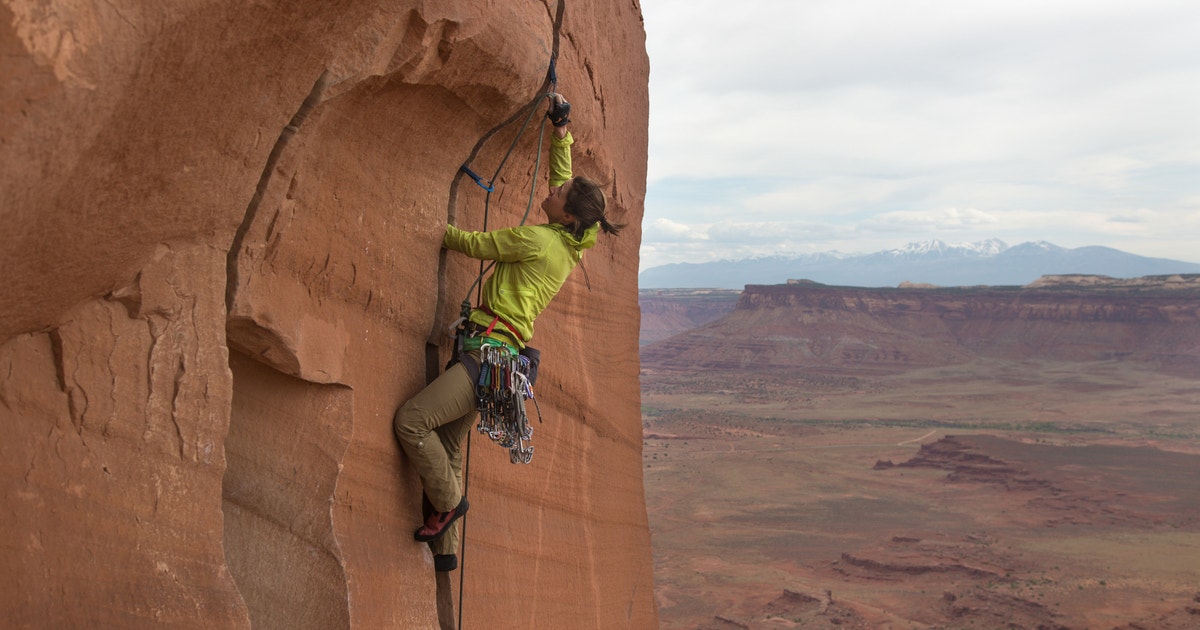Wesley Brown was standing on the desert floor last spring, looking up at a friend who was 100 feet into an ascent of a towering Utah cliff wall, when a Golden Eagle soared overhead. It was a powerful moment for Brown: his first close encounter with a raptor since he began working as a climber steward, a role that involves educating his peers about how to better care for the Indian Creek Special Recreation Management Area and the birds of prey that nest there. “That day sticks out not because of the climbs we got on,” Brown says, “but because of the connection and sense of place created by that eagle.”
Climbers are drawn to Indian Creek by the sandstone cliffs that splinter into nooks and crannies and the vast landscape of Bears Ears National Monument surrounding them. Those same attributes make it ideal for raptors, too. For thousands of years, falcons and eagles have returned to this area annually to raise their young, says Melissa Wardle, a wildlife biologist for the Bureau of Land Management, which oversees Indian Creek. Centuries ago, ancestral Puebloan people scaled cliffs in Bears Ears to build large dwellings; modern rock climbing took off at Indian Creek in the late 1970s.
With thousands of climbers visiting this piece of desert each year, potential arises for adventurers to inadvertently harm nesting birds and their young. Raptors are particularly sensitive to stress in nesting season, Wardle says. If adults can’t find a site without disturbances—such as climbers dangling off the rocks—they might not build an aerie at all. Though Peregrine Falcons and Bald Eagles have rebounded since the 1970s when DDT was banned, more than half of all raptor species worldwide are in decline due largely to habitat destruction, illegal shooting, and other human activity, according to the Peregrine Fund.
To protect the birds, each March the BLM asks the public to avoid portions of Indian Creek where raptors have nested in the past, including popular climbing areas with vivid names like The Meat Walls, Cliffs of Insanity, and Broken Tooth. “What’s important overall is just to let these birds try to have a natural [nesting] cycle, or as natural as we can make it with such a popular recreation area,” Wardle says.
Asking climbers to avoid favorite routes can generate frustration, so the BLM and the Access Fund, a climbing advocacy group, teamed up to defuse tensions. For the past three springs, Wardle and other biologists have monitored known nesting sites to confirm which are occupied. That allows the BLM to reopen the rest for recreation by June. The Access Fund, meanwhile, has posted two climber stewards at Indian Creek each spring and fall since 2021. They offer climbers coffee in exchange for a chat about the importance of practices like packing out trash and waste, staying on trail to protect the fragile desert ecosystem, and avoiding raptor nesting areas. “If you can diversify how you care about this place, you’re going to love it even more, and climbing is going to mean so much more to you,” Brown says.
Raptor closures happen not only at Indian Creek, but in climbing areas across the country. In Colorado, for example, the nonprofit Boulder Climbing Community has partnered with the U.S. Forest Service since 2010 to help scientists monitor birds each spring so that routes without nesting activity can reopen sooner. Even in places without official programs, climbers are often the first people spreading the word about nest sites, says Jim Ablao, founder of Chockstone Climbing Guides in Smith Rock, Oregon. Climbers don’t want to be dive-bombed while they’re suspended on a cliff face—Ablao himself has had a few uncomfortably close fly-bys, he says—but they also want to protect the birds that share their favorite places. “We can still do this activity in the habitat of these amazing animals and be able to do it harmoniously,” he says.
At Indian Creek, climber compliance with avoidance areas has only improved since the Access Fund hired climber stewards. During the nesting season, Wardle joins them at their information table with her spotting scope, training it on aeries to show climbers the impressive birds they are helping.
Last spring, Wardle saw something she hopes to witness every nesting season: A Golden Eagle flew straight up, tucked its wings beneath it to dive, and ascended again. The maneuver indicated that the eagle was showing off for a mate and was likely to stay for another season. Wardle watched it rise and dive once more before its wings caught the wind and carried it away—over hundreds of climbers dwarfed by the landscape they love.
This story originally ran in the Spring 2024 issue as “Aerial Allies.” To receive our print magazine, become a member by making a donation today.

